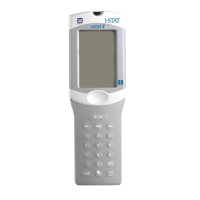Art: 716240-00D Rev. Date:03-Mar-10
2
When the calibration of a comparative method is uncertain, determine the customization setting by
minimizing the average bias between methods as follows:
• Check that the results from hematocrit controls for both i-STAT and comparative methods are
acceptable.
• If i-STAT hematocrit results obtained using the “
K
3
EDTA
” setting are consistently lower than those
on the comparative method, the “
K
2
EDTA
” setting may be a better choice. If agreement is better
after multiplying the “
K
3
EDTA
”-customized i-STAT results by 1.0425, the customization setting
should be switched to “
K
2
EDTA
”.
• Conversely, if i-STAT hematocrit results obtained using the “
K
2
EDTA
” setting are consistently
higher than those on the comparative analyzer, the “
K
3
EDTA
” setting may be a better choice.
If agreement is better after dividing the “
K
2
EDTA
”-customized i-STAT results by 1.0425, the
customization setting should be switched to “
K
3
EDTA
”.
• If an unacceptable system bias still exists, contact i-STAT Technical Support at 1-800-366-8020,
option 1.
HEMATOLOGY ANALYZERS AND K
2
EDTA AND K
3
EDTA SAMPLE COLLECTION TUBES
Hematocrit results on hematology analyzers from samples collected in K
3
EDTA and K
2
EDTA tubes will be
equivalent. This is because the osmotically-balanced diluent reverses the red blood cell shrinkage caused
by the anticoagulant.
5
It should be clear that results from K
2
EDTA and K
3
EDTA tubes will be equivalent, but
lower, on an analyzer calibrated to MH-K
3
EDTA than on an analyzer calibrated to MH-K
2
EDTA.
i-STAT has become aware that some customers have selected their i-STAT hematocrit customization
according to the type of EDTA anticoagulant in the collection tube used for samples for the hematology
analyzer. As explained above, the selection of the “K
2
EDTA” or the “K
3
EDTA” customization for i-STAT
analyzers is based upon the microhematocrit method (MH-K
2
EDTA or MH-K
3
EDTA) to which the hematology
analyzer is calibrated, rather than on the collection tube used for the hematology analyzer.
EXPECTED LEVEL OF METHOD AGREEMENT
Average i-STAT hematocrit results over a group of samples should normally agree with those from the
comparative method within ± 2 %PCV at 29 %PCV and below, ± 3 %PCV from 30 to 50 %PCV, and within
10% above 50 %PCV when the following conditions are met:
• i-STAT analyzers are customized correctly.
• Comparative analyzer is calibrated correctly.
• Sample handling is optimal for both i-STAT and comparative methods.
• Samples are unaffected by factors listed in the i-STAT Cartridge and Test Information sheet for
Hematocrit or in the user documentation for the comparative method.

